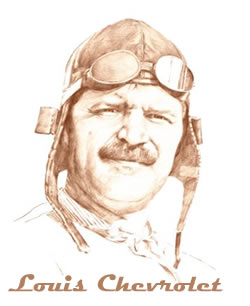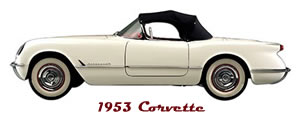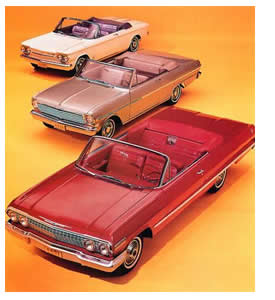 |
History of Chevrolet (1911)
In 1911, Chevrolet Motor Company of Michigan is incorporated in November of 1911 by Louis Chevrolet, William Little and Edwin Cambell, William Durant's son-in-law. Headquarters are in Detroit.
On September 13, 1915, Durant incorporates Chevrolet Motor Co. of Delaware. The new corporation includes the original Chevrolet Motor Company and becomes a holding company for auto companies Durant had put together after losing control of GM. 
In 1916, Durant announces that Chevrolet owns 54.5 percent of GM's outstanding shares and takes over the GM presidency from Charles W. Nash, who had been GM president from 1912 to 1916.
In 1918, General Motors buys the operating assets of Chevrolet Motor Company in May.
In 1921, GM decides to proceed with commercial application of Kettering's 'copper-cooled' engine, intended to replace the traditional piston engine. The initial target is to put the copper-cooled engine in all of Chevrolet Division's cars. The program is officially ended in 1923, with a total of fewer than 800 copper-cooled engines ever being produced and only 300 sold to dealers, all of which are recalled by GM.
In 1923, GM's first European assembly plant is established in Copenhagen under the name General Motors International A/S. It is to build Chevrolets for sale in Scandinavian countries, the Baltics, and Germany, Poland, Czechoslovakia, Austria, Hungary and Russia. The first GM vehicle assembled outside the U.S. and Canada, a Chevrolet utility truck, comes off the Copenhagen assembly line on January 7, 1924.
In 1924, William S. Knudsen becomes president of Chevrolet and joins the GM Board of Directors.
In 1929, Chevrolet introduces its new six-cylinder engine for use in commercial vehicles. This engine is nicknamed 'the cast iron wonder' for its remarkable durability.
In 1935, Chevrolet introduces the Suburban Carryall, a 1/2-ton truck with seating capacity for eight.
In 1950, Chevrolet introduces the Powerglide transmission, becoming the first competitor in the low-price field to offer fully automatic shifting.
In 1953, the Chevrolet Corvette is introduced. It is the first volume production sports car and the first production car with a plastic body to be produced in quantity.
In 1954, Chevrolet introduces small-block V-8 engine on 1955 trucks.
In 1958, Chevrolet introduces the El Camino, designed to combine big car comfort with the utility of a pickup truck, as a 1959 model.
In 1959, Chevrolet introduces the Corvair.
As part of the 1962 model year, Chevrolet introduces a new line of smaller cars, the Chevy II.
In 1962, The U.S. Department of Justice, Antitrust Division, charges GM and three Chevrolet dealer trade associations in criminal and civil suits for violation of the Sherman Act by restricting sales of Chevrolets in the Los Angeles area through discount houses. In 1966, the U.S. District Court for Southern California enters the final judgment enjoining GM from conspiring with any group or association of Chevrolet dealers to limit sales by such dealers or through discount houses or referral services.
In 1963, Chevrolet introduces its midsize Malibu as a 1964 model.
 In 1966, Chevrolet introduces the F-body Camaro as a 1967 model. The following January, Pontiac introduces the Firebird, its third line of cars, as a 1967 model. In 1966, Chevrolet introduces the F-body Camaro as a 1967 model. The following January, Pontiac introduces the Firebird, its third line of cars, as a 1967 model.
In 1968, Six passenger car and truck assembly plants previously operated by Fisher Body and Chevrolet Motor Division are transferred to the management of GM Assembly Division. Chevrolet is to have additional responsibility of engineering, producing and distributing a new American-built small car.
In 1969, Chevrolet announces that it is discontinuing production of Corvair.
In 1975, Chevrolet introduces the Chevette in October. This U.S.-built T-car was first designed by Opel and is also manufactured by GM subsidiaries in Argentina, Brazil and England and sold under the names Kadett, Chevette, Gemini and K-180.
In 1976, GM introduces its downsized Chevrolet, Pontiac, Oldsmobile, Buick and Cadillac full-size and luxury cars in September.
In 1979, GM introduces newly designed front-wheel-drive compact cars, the Buick Skylark, Chevrolet Citation, Oldsmobile Omega and Pontiac Phoenix X-body models.
In 1981, GM's new worldwide Truck & Bus Group is formed with responsibility for the design, engineering, manufacture, sales and service of all GM trucks, buses and vans in North America and throughout the world. In 1982, the truck manufacturing and assembly operations of GM Assembly Division, Chevrolet Motor Division, and GMC Truck and Coach Division are merged to form Truck & Bus Manufacturing Division. Headquarters for both are to be located in Pontiac, Michigan.
In 1983, GM and Toyota Motor Corporation agree to form a joint venture, New United Motor Manufacturing, Inc. (NUMMI), to produce a small Chevrolet automobile in the Fremont, Calif., assembly plant previously operated by GM.
The 1984 Chevrolet Corvette is introduced, with the car's first major styling change in 15 years.
In 1988, Chevrolet introduces its Geo line of small vehicles with Geo Metro, Spectrum and Tracker.
In 1993, Toyota and GM sign an unprecedented supply and sales agreement under which GM will build right-hand drive Chevrolet Cavaliers in the U.S. Toyota will purchase these models from GM and sell them in Japan.
In 2001, The Chevrolet Cruze is launched in Japan. Developed by GM and its alliance partner Suzuki, the Cruze is the first GM vehicle to be built in Japan since the 1930s.
General Motors announces that its Ste. Therese, Quebec plant, which builds the Chevrolet Camaro and Pontiac Firebird, will close in September 2002 in conjunction with discontinuation of the Camaro and Firebird models.
In 2002, the Chevrolet Corvette celebrates its fiftieth anniversary.
In 2003, GM announces that the 2005 model year GMC Envoy XL, Envoy XUV and Chevrolet trailblazer EXT will be the first vehicles to showcase its innovative Displacement on Demand fuel-saving technology, which enhances fuel economy without compromising performance or the ability to carry heavy loads. Displacement on Demand is to be a standard feature in the vehicles' optional Vortec 5300 V-8 engine. The technology, which boosts the Vortec engine's fuel efficiency by 8 percent, is also to be introduced in other GM engines in the 2006 model year.
The Chevrolet Corvette celebrates its fiftieth anniversary with a caravan of 5,000 Corvettes driven by owners from each of the 50 states converging at the National Corvette Museum in Bowling Green, Ky.
GM Powertrain introduces its new Ecotec 2.4-liter four-cylinder engine, which is to be available on the all-new 2005 model year Chevrolet Cobalt. Bringing variable valve timing to the Ecotec engine family for the first time, the Ecotec 2.4-liter engine offers improved low-end torque and fewer emissions than the previous 2.2-liter version.
In 2004, for a record sixth time, Chevrolet Corvette is picked as the official pace car for the classic Indianapolis 500 race.
General Motors delivers the world's first full-size hybrid pickup truck to Miami-Dade County during the tenth National Clean Cities Conference. The hybrid Chevrolet Silverado delivers up to 12 percent fuel economy improvement over comparable pickups, giving it the best highway fuel economy of any full-size truck on the market. Hybrid versions of both the Chevrolet Silverado and the GMC Silverado pickup are scheduled to go on sale in the fall.
Source: General Motors Corporation
AVAILABLE Chevrolet ADS BY DATE AND CATEGORY
1900 - 1919 |
1940 - 1949 |
1970 - 1979 |
|
|
|
1920 - 1929 |
1950 - 1959 |
1980 - 1989 |
|
|
|
1930 - 1939 |
1960 - 1969 |
1990 - 1999 |
|
|
|
Chevrolet Ads by year
|
|
|



